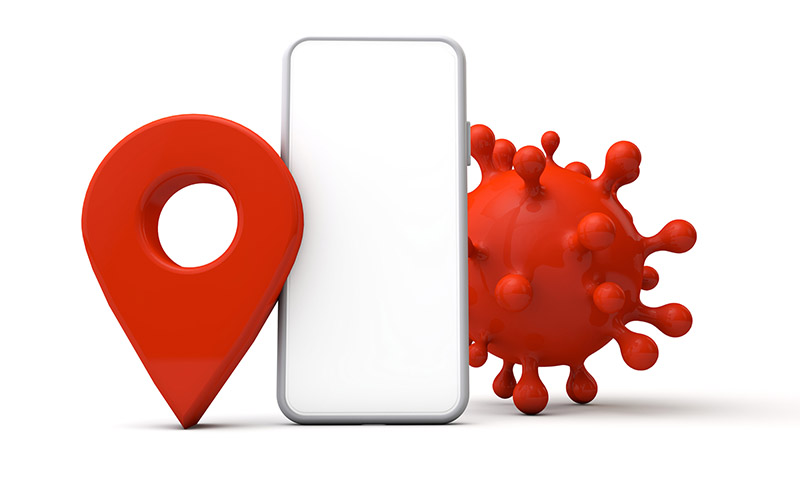
Recent Reopenings Have Brought New Risks
As cities across the country continue to reopen we have seen an acceleration of the spread of COVID-19. Like the mandate for masks, we need to have a mandate for contract tracing to reduce the spread. For employers and facility managers tasked with the responsibility of enabling employees to return to work safely, these latest developments have brought new headaches and challenges. Test and Trace remains the optimal method to control disease spread and allow phased reopenings to continue.
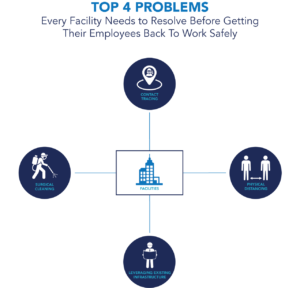
Figure 1.
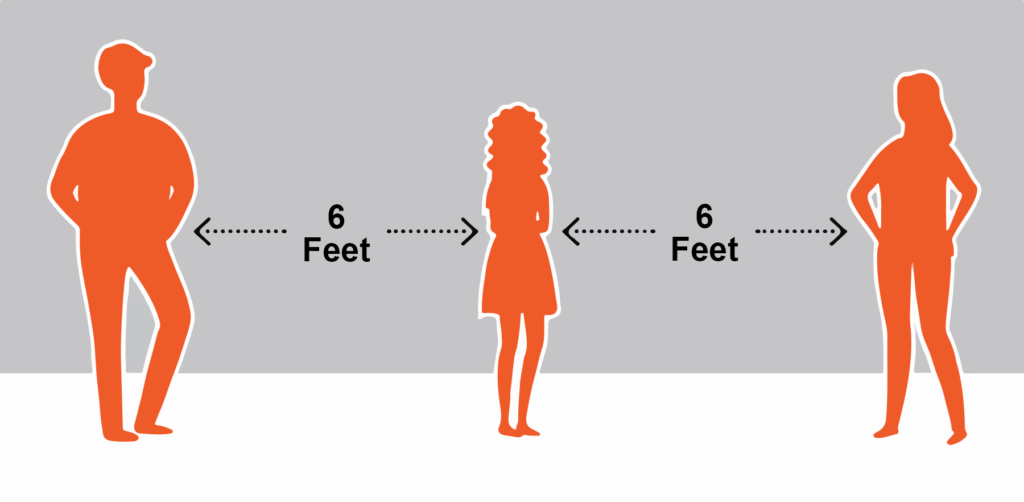
Figure 2.
Contact Tracing – It’s About Location and People
You may be familiar with the name, but what is contact tracing, and how can it work for you in a facility setting? It’s important to weigh the options and select the best approach for your organization. Contact tracing is about more than just identifying and locating people; it also involves reengineering working zones and rolling out advanced cleaning efforts.
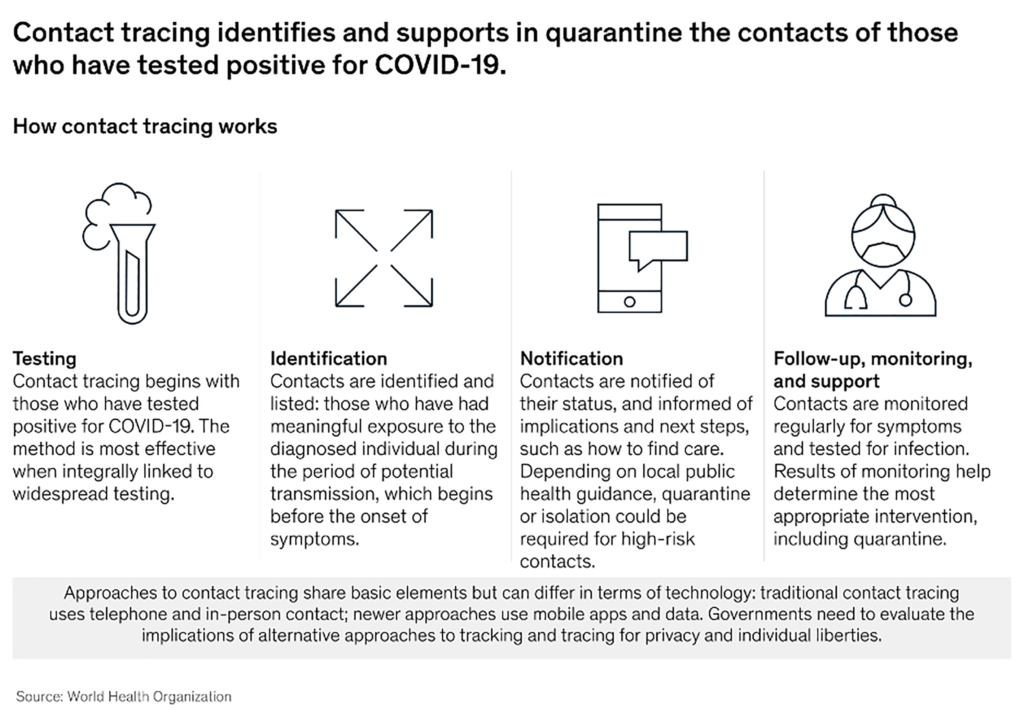
Figure 3.
Types of Contact Tracing – Know Your Options
There are two primary considerations in choosing your contact tracing solutions Open versus Closed and Manual versus Digital. Open versus closed is critical to privacy and protecting your employees anonymity and manual versus digital is about cost, speed and accuracy.
Open or Closed System?
In a facility, protecting your employees data is paramount. Who can see it? Where is it stored? Where are its limits? Here again, it is important to weigh your options and determine the best path for your organization.
Key differences include:
- Open: Data gathered using Apple-Google app services is typically shared with outside entities, such as the CDC or law enforcement.
- Closed: In a closed system, information employees share is confidential and not shared outside the confines of the organization. An opt-in approach targeting closed private networks provides the same protections as for personal identifiable information (PII) and will reduce risk of HIPAA (Health Insurance Portability and Accountability Act) privacy complaints.
Manual Contact Tracing also called Human Tracing
Characterized as a more “hands-on” approach, manual contact tracing typically relies on human one-on-one interaction to gather key information from infected persons. Some key considerations include:
- Higher risk of exposure. Surveys are completed in-person by health authorities, and there is a higher risk of exposure as the surveyor is required to be in the same physical space with the infected person.
- Slow and relies heavily on human resources. Manual tracing efforts are less effective in covering a large scale of the population in a given area and have slower return times.
- Reliant on individual recollection and subject to inaccuracy. Manual contact tracing is useful only for contacts that a surveyed person can identify and/or remember. Even if contacts are remembered, some will provide incorrect information or leave their information unwillingly – creating a break in the chain required to complete the full contact tracing cycle.
- Privacy concerns and fake contact tracer emergence. The nature of a manual contact tracing method can leave the door open for data to be shared with third parties and/or scammers.
Digital Contact Tracing
A digital contact tracing platform leverages available technology, such as QR code registries, Bluetooth tracking apps (i.e., Apple-Google app), GPS-based location tracking apps, and WiFi-based solutions and automation that integrate with existing facility infrastructures. Automated solutions including workflow become important to eliminate human interaction. Key factors include:
- Privacy is paramount. A digital or automated contact tracing program typically brings greater skepticism about how an individual’s personal data will be used, and who will have access to it. Bluetooth-based location tracking apps also can be conduits for cyberattacks, particularly if errors are made in the development stage. This is why facilities need to consider closed systems versus open systems.
- Fast and easy deployment. In facilities with existing WiFi networks, digital and automated contact tracing allows immediate collection of real-time data to pinpoint “at-risk” individuals, groups, and zones within a facility space.
- Ability to specify “zones” within your facility and identify “choke points.” Real-time data collection methods allow facility managers to monitor dwell time between employees should a positive case be identified so that individuals can be contacted, and a cleaning can be scheduled. Bluetooth apps do not provide location data.
- Potential reporting of false positives. Since over-the-air signals such as Bluetooth, penetrate glass, false positives can occur because of proximity or false proximity, i.e., a glass wall between two people.
- Lack of widespread adoption. A recent study by Oxford University found over 60% of a country’s population needs to download a Bluetooth tracing app for it to be effective. Translating these findings to your facility’s population means the larger the population, the more difficult it will be to adhere.
Example of how digital/automated contact tracing tools can be used to identify and track exposures, risk levels, locations within a facility, and possible other individuals for contact in the event of an exposure:
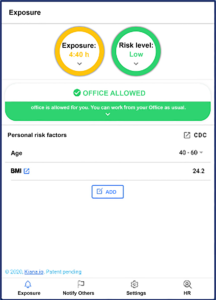
Figure 4.
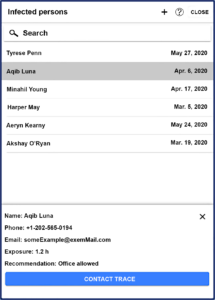
Figure 5.
New Challenges Require New Solutions: Contract Tracing is Here to Stay
There is no question that the COVID-19 pandemic has brought drastic and sustained changes in the ways we live and work. Contact tracing provides a strategy as well as a counter measure to safely bring North America back to work. Its ability to trace employees and potential exposures delivers valuable impacts for facilities management organizations in this critical time to protect overall health and prevent future outbreaks.
Steven Seiden is the president of Acquired Data Solutions based in Rockville, MD. He can be reached at [email protected]. Nader Fathi is CEO of Kiana Analytics based in Silicon Valley, CA. He can be reached at [email protected]. This is their first article for Facilities Manager.
Advertisement
Perspective on the Profession
Provides opinion and commentary on aspects of education administration, funding, and campus facilities management. To contribute, contact [email protected].
See all Perspective on the Profession.



